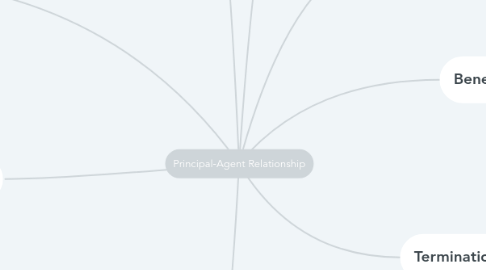Principal-Agent Relationship
Door Sabrina Schmick


1. How Agency Relationships are Formed
1.1. Agreement
1.2. Ratification
1.3. Estoppel
1.4. Operation of Law
2. Ratification of Agency
2.1. 1. The agent must have acted on behalf of a principal who ratifies the action
2.2. 2. The principal must know all facts in transaction, if not, the principal can rescind the contract.
2.3. 3. Principal must affirm the agent's act in its entirety.
2.4. 4. Principal and third party must have legal capacity to authorize transaction at the time of the act and ratification.
2.5. 5. Principals affirmation must occur before the third party withdraws.
2.6. 6. Principal must observe the same formalities when approving the act as it would have been initially.
3. Risks
3.1. Agents can create liability
4. Duties
4.1. Agent’s Duties to the Principal
4.1.1. Performance
4.1.2. Notification
4.1.3. Loyalty
4.1.4. Obedience
4.1.5. Accounting
4.2. Principal’s duties to the Agent
4.2.1. Compensation
4.2.2. Reimbursement and Indemnification
4.2.3. Cooperation
4.2.4. Safe Working Conditions
5. Agency Relationships
5.1. Employee
5.1.1. Agency law and employment law overlap
5.2. Contractor
5.2.1. those who hire contractors have no control over performance
6. Type of Agent Authority
6.1. Actual
6.1.1. Express- In clear, definite terms
6.1.2. Implied- do what is reasonably neccesary
6.2. Apparent- only apparent, not real
7. Termination of Agency
7.1. By Act of Parties
7.1.1. Lapse of time
7.1.2. Purpose achieved
7.1.3. Occurrence of a specific event
7.1.4. Mutual agreement
7.1.5. At the option of a party
7.2. By Operation of Law
7.2.1. Death or insanity
7.2.2. Impossibility
7.2.3. Changed circumstances
7.2.4. Bankruptcy
7.2.5. War

